Feige youlian | common questions and maintenance tips for extruder series products
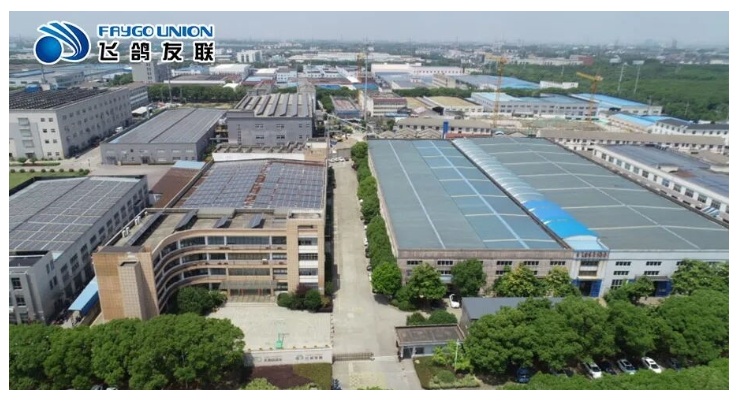
Jiangsu Feige Youlian Machinery Co., Ltd. is a high-tech enterprise specializing in the research, manufacturing, production, and sales of plastic machinery equipment. It is a private technology enterprise in Jiangsu Province, a specialized and innovative enterprise in Jiangsu Province, and a gazelle enterprise.
A comprehensive R&D and manufacturing enterprise focused on blow molding and filling production lines, as well as plastic pipe and profile extrusion equipment.
Today, we will introduce Feige Youlian extruder series products, common issues, and maintenance tips.
Extruder Product Introduction
2025·FAYGO UNION
Single screw extruder
The SJ series single-screw extruder is mainly used for extruding thermoplastic plastics such as PE, PP, PS, PVC, ABS, PC, PET, and other plastic materials. It features high output, excellent plasticization, low energy consumption, and stable operation. With the help of related downstream equipment, it can produce various plastic products such as plastic pipes, profiles, panels, sheets, and plastic pellets.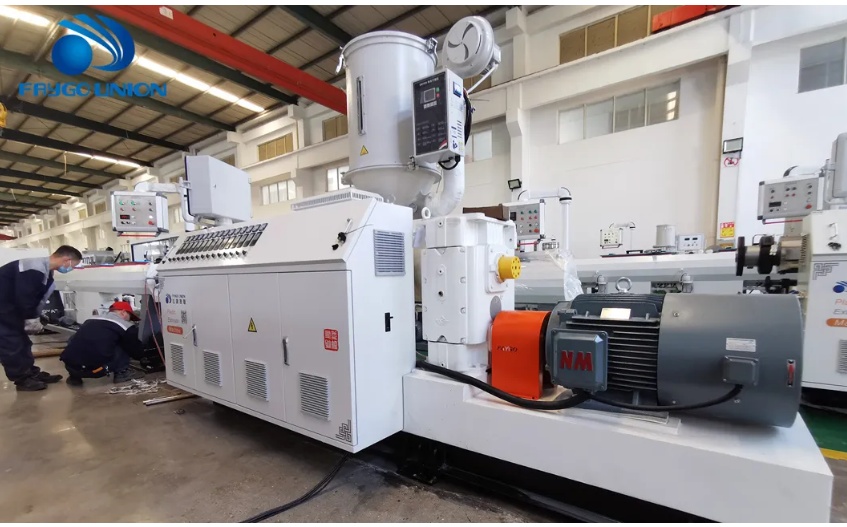
Twin-screw extruder
The SJSZ series conical twin-screw extruder mainly consists of components such as a barrel and screw, gear transmission system, metered feeding, vacuum exhaust, heating, cooling, and electrical control. It is suitable for producing PVC products from mixed powder. It has the advantages of good compounding, high output, smooth operation, and long service life. Equipped with different molds and downstream equipment, it can produce PVC pipes, PVC window profiles, PVC boards, WPC decorative panels, PVC pellets, etc.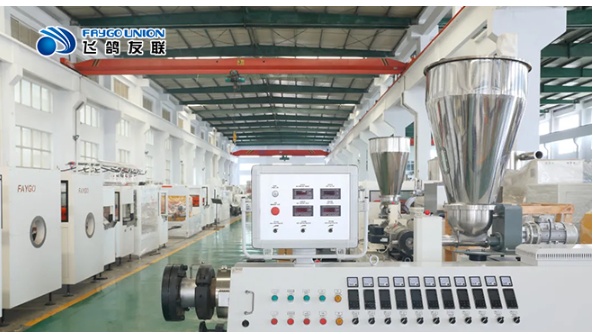
ABS lithium battery separator core tube extruder
Precision Leap: Our exclusive temperature control and traction systems achieve precise control of wall thickness tolerances at the 0-0.2mm level. This enhances the roundness and wall thickness uniformity of pipes by 40%, completely resolving issues of eccentricity and deformation caused by fluctuations in traditional equipment.
Thickness Breakthrough: Innovative screw design combined with enhanced melting pressure system enables stable mass production of ultra-thick ABS core tubes with a wall thickness of 15mm (surpassing the conventional limit of 13mm), increasing strength by 30%.
Diameter Innovation: Equipped with modular diameter expansion technology, pipe outer diameter production capacity leaps to 250mm (breaking through the market bottleneck of 180mm).
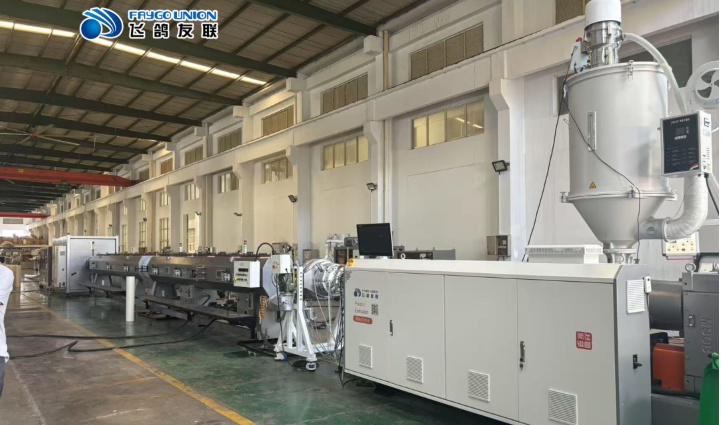
1600MM nuclear power plant coolant pipe production line
This equipment integrates core technologies such as ultra-large precision extrusion, multi-layer co-extrusion composite, intelligent closed-loop temperature control, and online precise thickness measurement to ensure the uniformity of pipe wall thickness meets military-grade standards, with physical performance far exceeding nuclear power specifications. Its multi-layer co-extrusion structure design achieves the perfect integration of barrier layer, reinforcement layer, and durability layer.
The equipment is equipped with an intelligent control system to ensure stable and efficient production, with full traceability of quality. It has the capability to produce pipes with an ultra-large diameter of 1600mm, successfully filling the gap in the domestic large-scale production of nuclear power-grade large-diameter PE pipes.
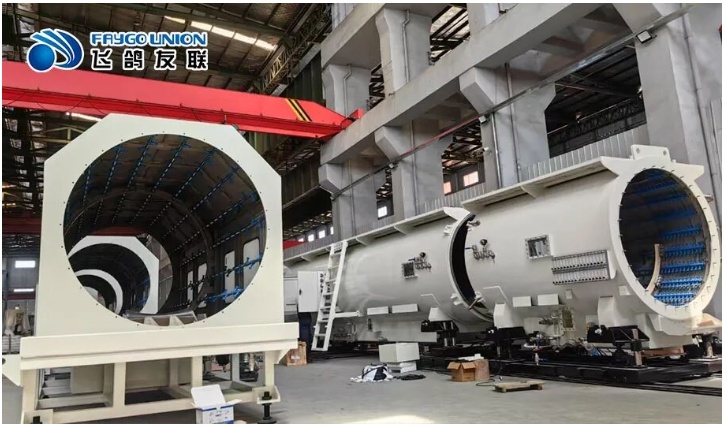
Common issues and solutions
2025·FAYGO UNION
What causes regular screw marks on the inner wall of the product?
High temperatures of the screw and material, or excessively fast rotation speed, may cause regular screw marks to appear on the inner wall.
What factors cause wavy patterns on the outer surface of the product?
A. The vacuum is too large.
B. Poor cooling effect
c. Uneven wall thickness of the product
D. The product is soaked in cooling water.
How to determine if the roughness of the product's inner wall is due to the process temperature being too high or too low?
Both can cause the inner wall to become rough. If the inner wall appears shiny or completely rough, and the exterior changes color, it indicates that the temperature is too high, especially if the temperature in the third and fourth sections of the barrel is too high. If there are raw material particles on the inner wall and the surface appears dull, it indicates that the temperature is too low. Therefore, when small products exhibit roughness, it is necessary to open them up and make a clear judgment.
Why do white products have black patterns?
If the gap between the screw and the barrel is too small or if the screw and barrel are severely worn, friction may cause patterns to form in a regular linear shape (this phenomenon generally appears as patterns at the bottom of white products after they come out of the mold).
B. Screw oil leakage
The issue with raw materials mainly involves pollution from recycled materials. When materials containing sulfur organic tin and materials containing lead salts are mixed, sulfur contamination occurs.
Why would the product become deformed and what measures should be taken?
A. The sizing sleeve itself is deformed, and the sizing sleeve should be replaced or corrected.
B. The setting water is too small and the vacuum is not large enough, causing the product to lose its shape and become out of round. The setting water or vacuum level should be increased.
C. The traction is too tight and flattened, the gap of the traction track should be appropriately adjusted.
D. The position of the support wheel inside the fixed box is too high, causing the lower end of the product to be flat. The support wheel should be properly adjusted.
Why are there scorched particles in the product?
Answer A, issues with the raw materials themselves.
B. Severe wear of the screw causes a change in clearance.
C. Material decomposition inside the machine head, with adhered residual material.
Why does the product have cracks?
Answer A, impurities mixed in the raw materials.
B. The processing temperature is too low.
C. Traction speed is too fast (large gap causing thinning of the product)
D. The ingredient structure is not ideal.
Maintenance Manual
Common maintenance methods
Equipment should be regularly kept clean and well-lubricated. Regular wiping and lubrication work should be carried out, while also maintaining the cleanliness of the surrounding environment.
2. Regularly check the oil level of each gearbox, ensure that the cooling water flows smoothly, and monitor the lubrication condition of all moving parts. If any abnormalities are found, promptly address them yourself or report to the responsible personnel for handling (gear oil should be added to the reduction box distribution box, and heat transfer oil should be added to the cooling box).
3. Regularly check the sealing and leakage of various pipeline filters and joints, and ensure the protection of cooling pipes.
4. The materials in the hopper must be pure and free from impurities, with absolutely no metal mixed in, to ensure that the barrel and screw are not damaged. Check whether there is a magnetic frame in the hopper during loading; if not, it should be placed immediately. Regularly check and clean the metal objects attached to the magnetic frame.
Machines are generally not allowed to run empty to avoid friction scratches between the screw and the barrel or mutual seizing of the screws.
6. After each production, immediately clean the residual raw materials and easily decomposable stop material machine inside the mold and barrel. If the machine is not in production for a period of time, apply anti-rust oil on the surface of the screw machine box and mold flow channel, and inject rust inhibitor into the water pump and vacuum pump.
7. In case of an interruption in the power supply, set all potentiometers to zero and stop the drive and heating. Once the voltage is back to normal, reheat to the set value and maintain the temperature (for some products, after removing the mold) before starting the machine. This prevents damage to the equipment from starting cold.
8. Timely perform inspections and tighten fasteners on machines, such as heating ring screws, terminal blocks, traction machine clamp blocks, cutting machine fixtures, and external protective elements on machines.
【Copyright and Disclaimer】The above information is collected and organized by PlastMatch. The copyright belongs to the original author. This article is reprinted for the purpose of providing more information, and it does not imply that PlastMatch endorses the views expressed in the article or guarantees its accuracy. If there are any errors in the source attribution or if your legitimate rights have been infringed, please contact us, and we will promptly correct or remove the content. If other media, websites, or individuals use the aforementioned content, they must clearly indicate the original source and origin of the work and assume legal responsibility on their own.
Most Popular
-

Zf asia-pacific innovation day: Multiple Cutting-Edge Technologies Launch, Leading Intelligent Electric Mobility
-

Mexico officially imposes tariffs on 1,400 chinese products, with rates up to 50%
-

List Released! Mexico Announces 50% Tariff On 1,371 China Product Categories
-

Fire at Sinopec Quanzhou Petrochemical Company: 7 Injured
-

Argentina Terminates Anti-Dumping Duties on Chinese PVC Profiles! Kingfa Technology & Siemens Sign Digital and Low-Carbon Cooperation Agreement






